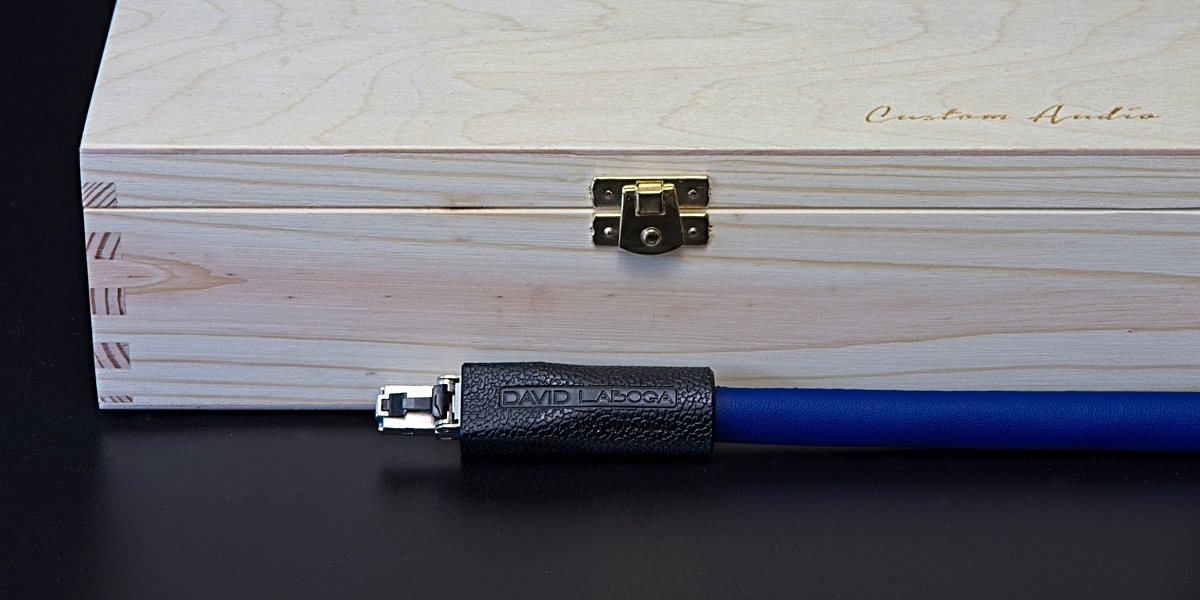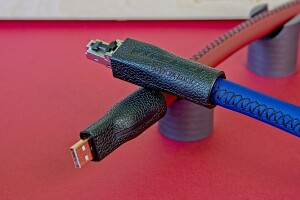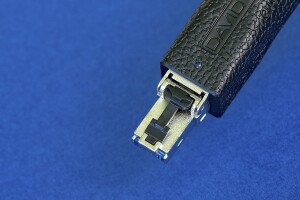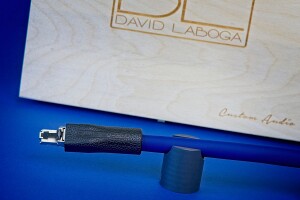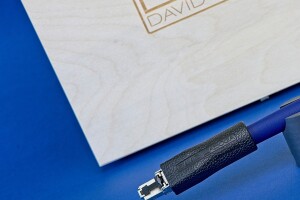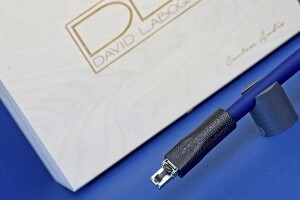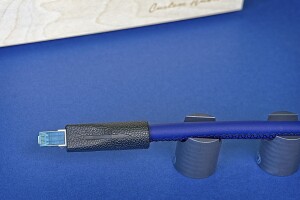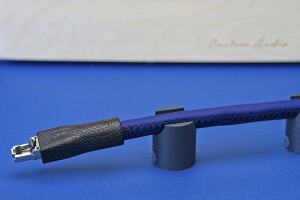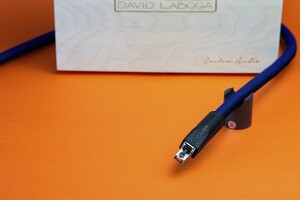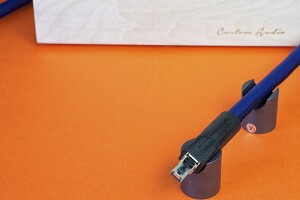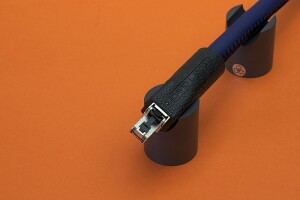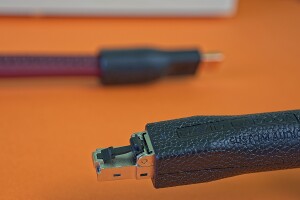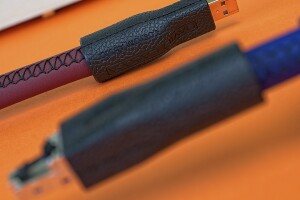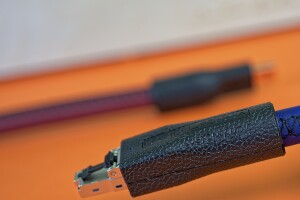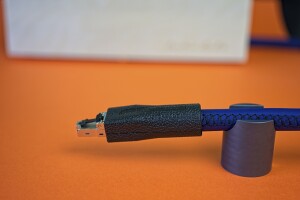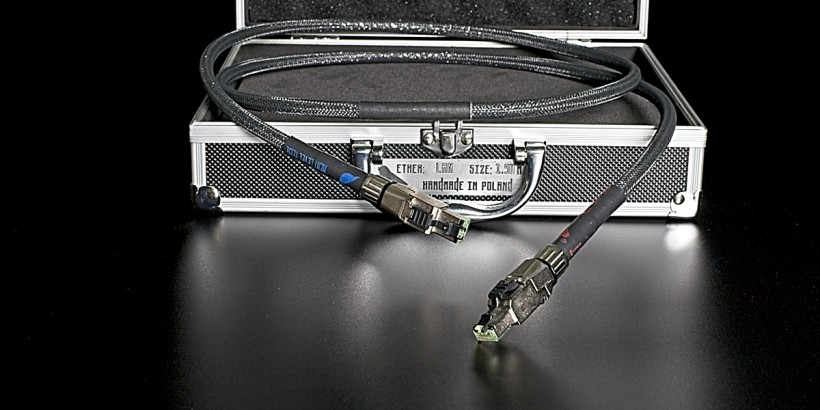After the highly encouraging experience provided by the David Laboga’s entry level Expression Emerald USB cable, which turned out to be an extremely musical beast and became a part of my reference system, the time has come for yet another proposition prepared by this brand for owners of high-end music files-based systems. For the test I received a high-end Ethernet cable, namely the David Laboga Digital Sound Wave Sapphire Ethernet.
Introduction
The last great digital revolution in audio began with an introduction of D/A Converters featuring USB inputs. Utilizing this standard, even though it was not developed for the purpose of music transmission, meant that any computer could become a source for an audio system. It took several years to refine music files transfer via the USB interface in a way that satisfies expectations of audiophiles. I would even say, bearing in mind that it took about 30 years to perfect CD playback, that the process for USB DACs is by no means over, although the progress has already been enormous.
To improve quality of music files playback designers focused their efforts in several areas. One of them was the signal’s source, i.e. computers, today often dressed in audiophile chassis, supported by high-class linear power supplies, using specialized software, and so on. They also targeted receivers of the signal in DACs, and the ways to process this signal. Last but not least, we’ve witnessed an introduction of audiophile cables that connect audiophile servers with DACs, as well as those used inside servers, plus various accessories intended for further sound quality improvement. For quite some time the USB standard was the main focus of all the work, hence today almost every new DAC features an USB input supporting hi-res PCM and often also DSD signals and one can easily find dozens, maybe even hundreds of audiophile USB cables, some better than others.
The USB standard, if only because it was not created with high-end audio in mind, has its drawbacks that designers have learned to (quite effectively) overcome. However, a few years ago a new approach emerged focused on using yet another option of delivering high quality signal to D/A Converter, one that is readily available for virtually every computer, i.e. a network connection. It is true that wireless communication (Wi-Fi) is more popular nowadays, but in audio, at least in the high-end segment of the market, a cable connection is preferred – the Ethernet, also known as LAN. Today, still the number of DACs featuring a proper input is smaller than those with USB inputs, but there are already enough of the former to take this solution into account.
And since there are DACs with Ethernet inputs, specialized audiophile cables are also needed. Until a few months ago, my experience with the use of Ethernet for audio playback was limited only to some devices that I had a chance to review. Nonetheless these experiences were so promising that I finally asked LampizatOr to upgrade my trusted Pacific DAC by adding a LAN input to it. After a few months of getting used to the „Ethernet” sound using decent, but not specialized LAN cable(s), the time has finally come to check whether, like in the USB case, Ethernet cables designed with audio quality in mind make any difference. Let me, as a person who hears the differences between digital cables, to completely skip the argument that these are only ones and zeros, so any digital cable, Ethernet ones included, should not be able to affect the sound. To my ear they always do, but as the LAN standard was a novelty to me, I had to try it out and judge based on actual experience. Since it was Mr. David Laboga’s USB cable that impressed me so much, I decided to reach out to him and ask for a loan of his LAN cable(s) for assessment.
Same as his USB cables, also the Ethernet ones are grouped in one series with three models/levels. At some point between the moment I received these cables for this review and time when I was ready to publish my findings, David changed the names of his Ethernet cables. The series is currently called Digital Sound Wave, while the individual models are (from the lowest to the top one): Emerald, Sapphire and Ruby. As you can see, the purpose of this change was to unify names of both, USB and ETHERNET cable models. While in the case of the former I tested the „entry” level model, the Emerald (see HERE), when it came to LAN cables, for this review I received two units of the middle model, the Sapphire. The main color changed from green (or emerald) to blue (or sapphire), the quality of workmanship of the latter is even higher, and the aesthetics, although flawless already in the cheapest model, reached a new level due to the beautiful leather finish (now available for both, USB and LAN cables starting from Sapphire level up). Yet, here comes a small teaser of an upcoming review, the top model (I’m testing the USB version) Ruby, fully dressed in a ruby leather sleeve, looks probably even better, even more exclusive, although the blue one is gorgeous too.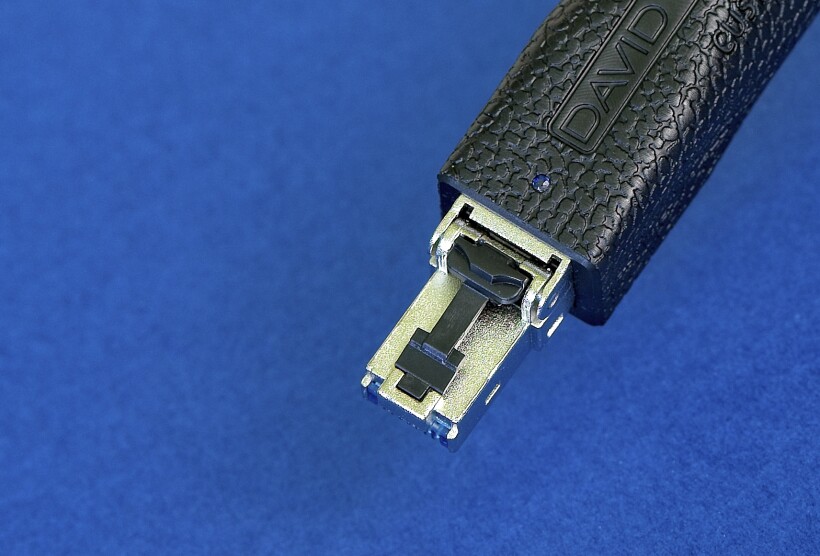
Design and features
Like the rest of David Laboga’s digital cables, the Digital Sound Wave Sapphire Ethernet comes in a fairly simple but elegant wooden box. High-class, custom-made RJ45 plugs are additionally secured with small, soft, black fabric bags for transport. The same bespoke plugs are used in all cables from this series, which speaks of their class. Their contacts are made of copper and then gold-plated. Even if the box itself is not a sufficient indication, after taking Sapphire out of it there is no doubt that we are dealing with an exclusive high-class product. The leather finish of the cable is impeccable and simply put gorgeous. Here’s what manufacturer says about it:
„The cable’s leather sleeve is hand-sewn. We use natural calf leather for our cables, because ecology is a very important issue to us. This is why we decided to use natural leather, which is a “side effect” of slaughtering animals (for meat). Not using the leather would be a waste and disrespect for animals in our view. An additional argument in favor of the use of natural leather is the fact that, unlike the so-called eco-leather, it is a completely biodegradable material.”
Such a full, leather, precisely sewn finish, partially black around the plugs, and on most of the length dark blue (sapphire, I guess), looks phenomenal, simple but elegant. And to be clear – I am not a fan of leather in general at all. I don’t use it apart from belts and shoes, and yet I just loved it this time! There are embossed inscriptions on the sections made of black leather – i.e. the brand and model name, as well as arrows showing the direction for connecting the cable. There is one more element in addition to the leather finish distinguishing the two more expensive models of Digital Sound Wave cables (Sapphire and Ruby) – tiny, but genuine stones – as the names suggest, sapphire and ruby. I guess the photos won’t really convey the exquisite looks of these cables, but in reality they both look so good it is a real shame they have to be installed behind connected components.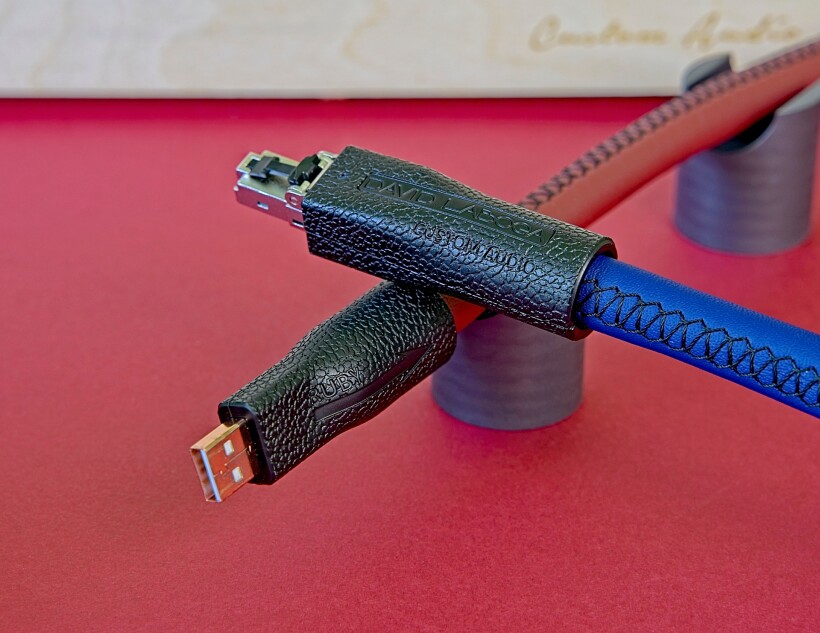
What’s inside the leather sleeve? The Polish manufacturer is not one of those who publish a list of materials, cable’s design, nor colorful arguments “explaining” why his cables are better than others. The approach is simple – give it a try, listen and assess for yourself. That explains why all I managed to find out about the Sapphire is that it is not some generic cable cut for the length and packed into a fancy sleeve. It is actually hand-made braid of copper wires of various cross-sections and varying purity (!), designed and build for audio applications. Making it by hand is also a reason why it is not possible to manufacture runs longer than 3 meters. Hence the Sapphire Ethernet is available in : 1, 1.5, 2, and 3m lengths. The manufacturer recommends a break-in period of minimum 100 hours, but points out that optimal results are obtained after about 200 hours of use.
Sound
As I mentioned, using Ethernet as an interface to send signal from a music server to a DAC is a fairly new experience for me. Actually so new that until now I have not acquired any audiophile LAN cables, only high-class, non-audiophile ones, for myself, even though some high quality LAN cables had passed through my system on the occasion of various reviews. One of the best ones came from the Stavessence brand, which clearly showed me that a good cable of this type does makes a difference. However, since at the time I was using some tested DAC and not my own, I was not able to fully assess the scale of the changes. Now, thanks to the David Laboga’s cables, I finally had an opportunity to check their performance in optimal conditions, also due to the newly tested and purchased after the test for my reference system JCAT NET Card XE (see HERE). During the test I also used yet another JCAT product from the same test, i.e. JCAT USB + LAN Ground Conditioner.
We agreed with Mr. David that I would get two Digital Sound Wave Sapphire Ethernet cables for the test, i.e. the middle model from the current lineup. Having two cables at my disposal allowed me for a more comprehensive test as I was able to use one of them between the LampizatOr Pacific and the Silent Angel Bonn N8 switch (paired with the company’s Forester linear power supply), and the second one between the switch and my custom music server. The idea was to check where in the system a single Ethernet cable would do the most impact on sound quality, and whether using two of them would offer additional benefits.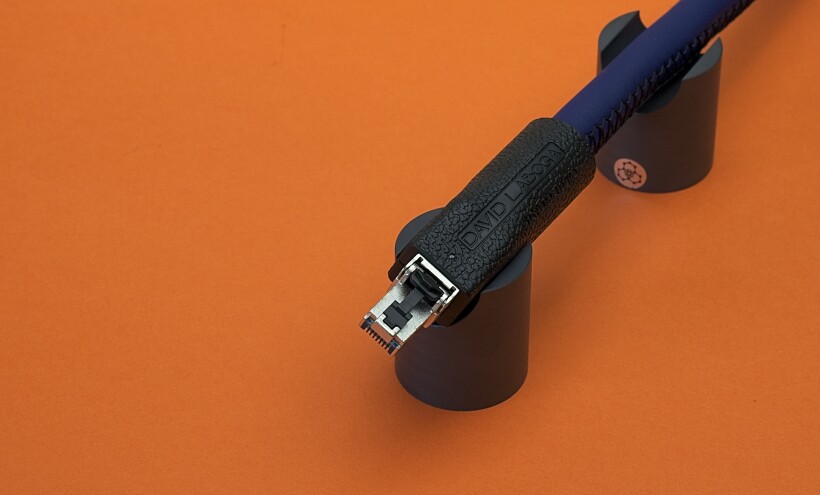
I started with a comparison that was supposed to be the key one, i.e. with the David Laboga Sapphire Ethernet cable connecting my DAC with the Silent Angel switch. I chose a few tracks in high resolutions files, both in PCM and DSD, and started comparing the LAN cables switching between them only on the Pacific side. I had been listening to music for several months using the aforementioned „standard” LAN cable, which is a well-made, but non-audiophile one, and I had been using this connection between server and DAC probably as often as the USB. On the other hand, the David Laboga Expression Emerald USB changed the proportions a bit to its favor, as it enhanced the performance of my system with its beautiful fluidity, coherence and simply put, a higher musicality, which I personally highly value. But that’s not the point here … The thing is that despite having great USB cables and the fantastic Ideon USB signal regenerator, I still found myself listening to the music quite often using this „ordinary” LAN cable. Which indicated that this interface was definitely worth my attention, so I expected that changing the latter to a high grade audiophile Ethernet cable would make a difference, and not a small one.
I was right, although it wasn’t that obvious from the very first second of the very first track. The changes to the sound were by no means spectacular, or even less so showy. What Sapphire did was rather a basic work, so to speak, starting at the very core of the sound, or rather the music, and influencing what I heard from the speakers from the inside. The thing is that the Digital Sound Wave Sapphire Ethernet seemed to organize the sound from the inside out, put all its elements in proper order, assigned them appropriate places and made sure that each piece of information fulfilled its role.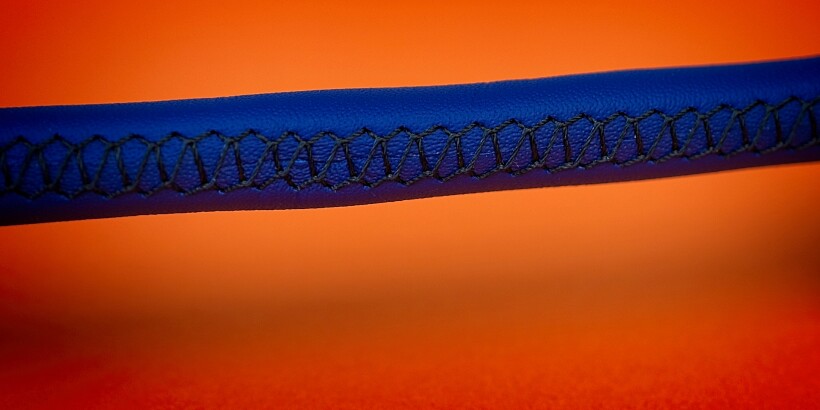
When all that was done, what I heard was way more coherent, more relaxed, fuller, richer, smoother and more … I don’t want to say „analog”, so let me go with „non-digital”. After a while, I realized how much the resolution improved too, how much more information “appeared” in the presentation. I took “appeared” in quotation marks because the thing is not that the Sapphire by itself conjures up some sounds that are not actually there in the recording. The David Laboga’s LAN cable by arranging all of these, even the smallest pieces of information, on the one hand, converts them into full-fledged elements of a larger whole, and on the other hand, they become much easier to notice, clearer and hence the impression is that they have suddenly „appeared”.
Such approach to sound reproduction also reduced the level of noise, which we theoretically can’t hear, but that with lower quality cables lurks in the background hindering the perception of the sound. When we manage to get rid of it, which in this case was sort of a collective effort of a whole range of elements – from the JCAT NET XE card powered with the excellent FERRUM Hypsos power supply, to the tested David Laboga cable – the sound becomes much clearer, more transparent, and at the same time more saturated, richer, even timbre of instruments and vocals seems deeper. The thing is that there is a significant improvement in terms of resolution and it makes the sound denser, so apparently, despite its obvious clarity, also darker. Hence it takes a while to actually appreciate how much more open and effortless at the same time the presentation gets due to the properties of the Digital Sound Wave Sapphire Ethernet cable.
I could hear it perfectly, for example, in a track from the generally dark sounding live recording of Herb Alpert and Hugh Masakela. The maestro’s trumpet with a standard cable seemed quite dull, with the David Laboga’s Sapphire it combined this natural (!) feature with sonority, one that, when necessary, could even pierce, but even then it sounded incredibly natural, non-aggressive and never bright. The Sapphire also „opened” the space around the musicians and filled it with air. With it it seemed to me as if I was finally able to “see” not only the stage and the front rows of the audience, but the entire Roxy Theater space. All this, of course, due to a much better use of the wealth of tiny acoustic cues, that had been captured on the tape, and which with the “standard” cable were not properly used to create the “aura” and atmosphere of the event.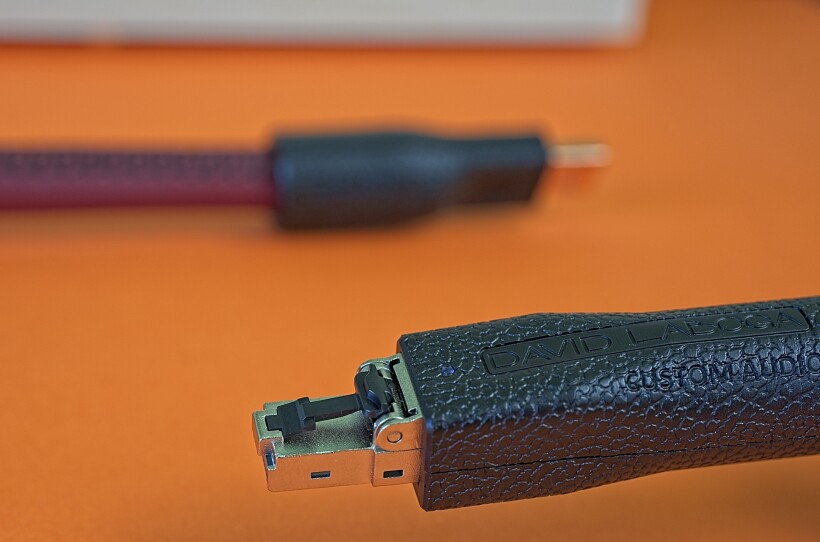
The latter impression was partly due to the fact that while this standard cable focused quite strongly on the foreground, showing it close and losing sight of other events at the same time, the Digital Sound Wave Sapphire reached much further, deeper. In this way, it much better reflected everything that happened in the background, and thus also the acoustics of the concert and the lively participation of the audience. It was only with the tested cable that an impression arose, that I love good concert recordings (if a given system / component is able to convey it) for, i.e. immersiveness, a sense of (almost) participating in the event instead of just listening to even a very good recording. Listening even in a top system will never provide the same impressions, same feeling as actual participation in a live event, but the point is to get closer to it. The tested David Laboga LAN cable, plugged between the Pacific and the switch, did a great job in this regard.
On the “This is not America” from the “Heroes expanded (A tribute to David Bowie)” my attention almost immediately was caught by the bass. Diving really deep, heavy, powerful, dense, defining the very pulse of the piece. The latter was also marked with the standard cable, but it was definitely not so powerful, hence it played a clearly less important role than with the Sapphire. At the same time, the tested cable made the low tones more compact, better defined and the attack of the sound was faster. As shown better by the track with Ray Brown on a bass from “Soular energy”, also the decay phase with David Laboga was longer and fuller.
After getting used to the much greater presence of the well-differentiated, dynamic, energetic bass, I was finally ready to also appreciate the clarity of the timbre of both the vocal on the first disc (i.e. purity of the midrange) as well as the maestro’s double bass on the second one (the lower range). In addition to allowing me to fully appreciate the technical proficiency of the performers, the Digital Sound Wave Sapphire in a more organic, richer, more expressive and truer way reflected the tonality and texture of both, vocals and the double bass. Let’s add to mix the generally more expressive presentation, compared to which the standard cable sounded just emotionally flat (although it wasn’t really – it was just a matter of a big difference, a clear contrast in this respect between the two), fantastic dynamics, where the difference at the micro level in favor of the Sapphire was even bigger, and we get a performance that is overall dramatically better.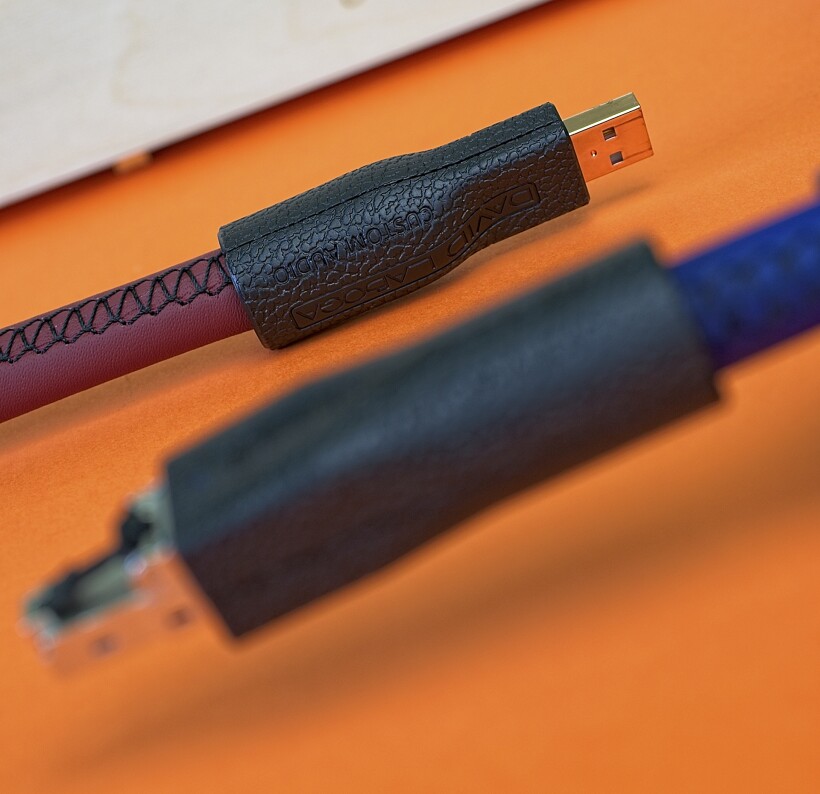
The influence of the Digital Sound Wave Sapphire Ethernet cable when used between the DAC and the switch turned out to be truly significant and definitely positive. So it was time to check what would happen when I plug a single audiophile LAN cable between the switch and the server, the JCAT NET XE card, to be precise, this time connecting the DAC with switch using “standard” cable. This is an important question because the Sapphire is already quite expensive, so purchasing two of those may be too much of a financial burden for some, if not most, audiophiles. So if, for whatever reason, one can only use one high-end Ethernet cable in one’s system, where will it be more beneficial? Before the test, the answer seemed simple to me – the cable supplying the signal to the DAC should be the first choice. After a few, even a dozen or so actual trials, listening to short fragments of various tracks, it wasn’t that obvious to me anymore. Connecting one Sapphire Ethernet cable between the server and the switch introduced changes, first of all, similar to those I’d heard when using the same cable to connect the DAC with switch. Secondly, the scale of the cables influence was … similar.
This conclusion was so surprising, even despite the fact that I basically agree with the theory that the system sounds as good as its weakest link, that instead of short comparisons with quick cables switches, I decided to listen to a few albums with the David Laboga’s cable first plugged into the server and then to the DAC. Our hearing sense and perception of the sound tend to accommodate or get used to the sound after a while. And yet it was only after such longer listening sessions that I finally realized that with the Sapphire plugged into the Pacific, the sound was bit more open, there was a bit more air in it, the elements of room’s/recording’s acoustics were more present – in other words, these were all those elements that I liked the first part of the test.
In the second option, the sound was a bit more weighted, although the accent (of this weight) seemed to be located a bit higher – in the lower midrange / upper bass. I must emphasize that all the aforementioned differences tipping the scale one way or the other were really not that big. In both of these applications, the Digital Sound Wave Sapphire Ethernet did an excellent job, clearly elevating the performance of the system. The bottom line – having only one David Laboga LAN cable at my disposal, I would connect it between the switch and the DAC. In my (!) system it offered a slightly better balanced and more open sound, which aligned with my personal taste. Still, in a different system, or based on different user expectations, connecting the Sapphire Ethernet between the server and the switch could offer more benefits, or better suit particular taste of a user. What I know for sure is that working as either of these two links in the system, the reviewed cable will perform perfectly well, even in truly high-end systems.
I could end the assessment here, except that I had two Sapphire cables at my disposal. So I could plug them both in at the same time to assess, whether the advantages of two cables in my system are worth spending twice the money. From practical standpoint that question was, whether with two cables a combined impact on sound quality is greater than a simple sum of what I’d already known each of them introduced individually? I plugged the second David Laboga’s cable into the system between my switch and DAC after listening for some time to the music with one cable sitting between the server and the switch. To be clear, without the second one, as I’d mentioned earlier, the sound was really excellent and I didn’t really expect any major changes.
And yet plugging in the second Sapphire was immediately noticeable. The music, or the instruments, seemed to catch even more breath, the presentation was even more airy, decay phase seemed longer, fuller, presentation got even more spacial, and the musicians were even more present, more „here and now”. Although I have to repeat myself again, I still have to do it – the key feature of all David Laboga’s digital cables I had listened to so far was the fact, that they made digital music sound… less digital. The Digital Sound Wave Sapphire Ethernet is a perfect example of this „effect” and two of them used simultaneously in a system even further enhanced this welcomed outcome without any downsides that I could recognize.
Long story short, when using two cables, the “Sapphire effect” accumulated, i.e. I benefited not only from a combination of the advantages observed earlier, depending on the place where one Ethernet cable was plugged in, but also of the so-called synergy effect. The final impact on the sound of two Digital Sound Wave Sapphires was greater than the simple sum of the contributions of each of them individually. Repeated attempts with either of them disconnected and than using both simultaneously yielded the same results each time. Longer listening sessions with one or two cables in the system confirmed the advantage of the latter each time. Obviously, the gain from plugging in the second piece was clearly smaller than from adding the first one. But if you have any experience in audio you must realize that this is exactly how it works, that’s the rule of diminishing returns. Still, as in our hobby we are constantly looking for perfection, and the closer we get to this (unattainable!) goal, the more each successive, smaller and smaller progress costs us. Which does not change the fact that we appreciate each of these steps towards the goal anyway.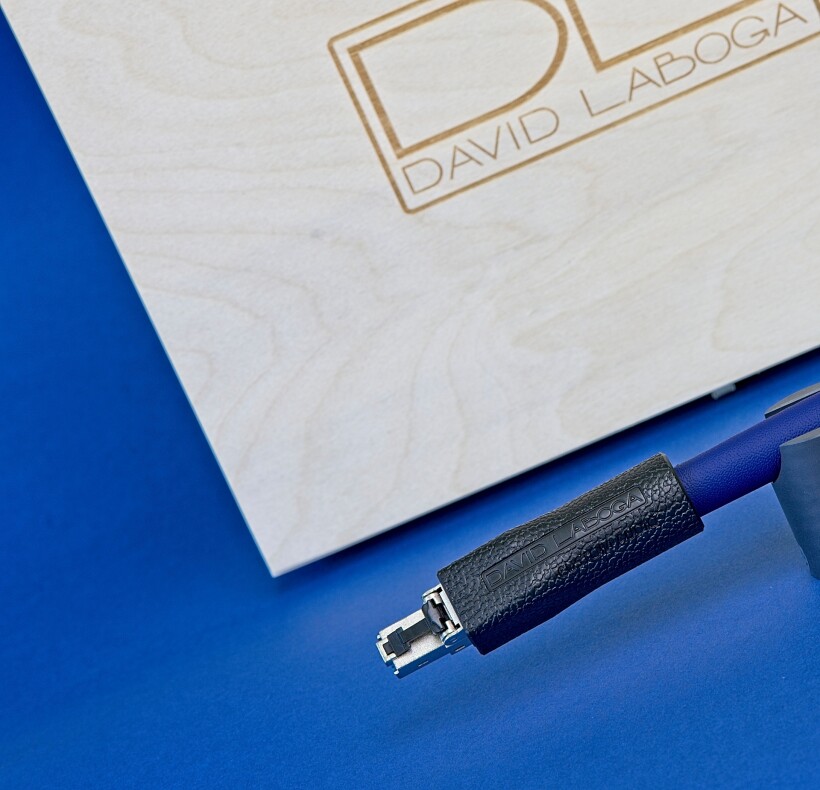
Summary
To put it as simply as possible, with two of David Laboga’s Digital Sound Wave Sapphire Ethernet cables in the system, the musical experience was better, more enjoyable, highly immersive and even more rewarding. In my humble opinion, if only the budget allows, you should go for two Sapphires, because the system will sound better than with one. To be clear, one will also do an excellent job – in my case a bit, not much, but still better between the DAC and the switch. You can also try the top model, Ruby (here I extrapolate my experience with the USB cable), because it will probably do the same task in an even more sophisticated, more complete way.
Still, even two Sapphire’s in a system probably leave some room for further improvement (though that sounds crazy). For me, I could use another one to connect my NAS, where I store audio files, to the switch (both benefit from linear supplies). I could theoretically connect another, or even two more (because I use a LAN optical isolator here), between the switch and a wall LAN socket. But every madness must have its limits. So let’s stick to at least one or two units. For me, disconnecting both David Laboga’s Ethernet cables, i.e. the return to the state from just a few weeks ago, made me feel reluctant to even listen to music from audio files. The difference in both, the class and character of the sound in favor of my analog system with Janusz Sikora’s turntable in the lead role, seemed to be much greater than I remembered.
Two Sapphires in the system meant that (although the vinyl records remained my preferred music medium and it probably will never change) I did not look longingly at the J.Sikora Standard Max. I listened to music files for hours, even days with a smile on my face and my limbs tapping out a beat. If that’s what you’re looking for, check out Mr. David Laboga’s cables – the Digital Sound Wave Sapphire is yet another proof that he is a man who knows what he is doing and what is important in music (!). If you’re after highly analytical cables, look somewhere else. Were it not for the fact that we are giving our award, the VICTOR, only to the best products we review, it would go to Sapphire for sure. However, having already a taste of the top Ruby USB, I have to save the award for future, for if, or (hopefully) when I have a chance to test the Ruby Ethernet.
Prices incl. VAT (when reviewed):
- David Laboga Digital Sound Wave Sapphire Etherner: 1m -1060 EUR, 1.5m – 1181 EUR, 2m – 1305 EUR, 3m – 1550 EUR
Manufacturer: DL Custom Audio ; David Laboga
Associated equipment:
- Digital source: a passive, custom server with WIN10, Roon, Fidelizer Pro 7.10, JCAT NET XE and USB Femto cards with FERRUM HYPSOS power supply, KECES P8 (mono) linear power supply for the server, JCAT USB Isolator
- D/A Converter: LampizatOr Pacific +Ideon Audio 3R Master Time (USB signal regenerator)
- Analogue front end: J.Sikora Standard MAX turntable, J.Sikora KV12 tonearm, AirTight PC-3, phonostages: Grandinote Celio mk IV, ESE Lab Nibiru V 5.
- Power amplifiers: GrandiNote Shinai, Art Audio Symphony II (modified)
- Preamplifier: Audia Flight FLS1
- Loudspeakers: GrandiNote MACH4, Ubiq Audio Model ONE Duelund Edition.
- Interconnects: Hijiri Million, Hijiri HCI-20, TelluriumQ Ultra Black, KBL Sound Zodiac XLR, David Laboga Expression Emerald USB, TelluriumQ Silver USB, David Laboga Digital Sound Wave Sapphire Ethernet
- Speaker cables: LessLoss Anchorwave
- Power cables: LessLoss DFPC Signature, Gigawatt LC-3
- Power: Gigawatt PF-2 MK2 and Gigawatt PC-3 SE Evo+; a custom power line with Gigawatt LC-Y in-wall cable; Gigawatt G-044 Schuko and Furutech FT-SWS-D (R)
- Racks: Base VI, Rogoz Audio 3RP3/BBS
- Anti-vibration accessories: ROGOZ-AUDIO SMO40 and CPPB16 platforms and ROGOZ AUDIO BW40MKII feet, Franc Accessories Ceramic Disc Slim Feet and Wood Block Platform


